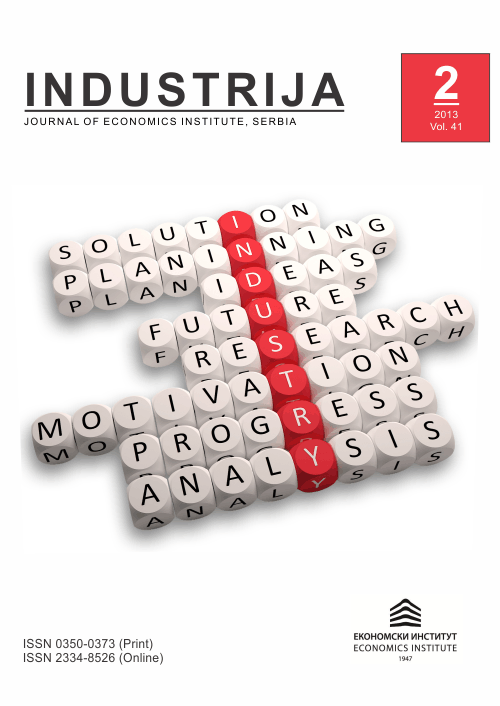Feldstein-Horioka puzzle – a myth or reality: case of Serbia
Abstract
In this paper we have presented the results of a research of presence of Feldstein-Horioka puzzle in Serbia for the period between 1997 and 2010. By applying the technique of time series cointegration (Johansen and Engle-Granger test) we did not manage to estimate any cointegration relation betweet the gross domestic savings rate and gross domestic investments rate, as well as between their absolute real values. Based on such findings, we rejected the hypothesis that empirical data in Serbia indicate the presence of Feldstein – Horioka puzzle. Descriptive-statistical analysis has shown that almost all that is produced in Serbia is consumed, which results in a very modest gross domestic savings, we would say negligible ones compared to gross domestic investments. This fact clearly shows that gross domestic investments are not limited by domestic savigs, which is consistent with relatively free flow of capital Serbia has with foreign countries.
References
--
Blanchard, O.J., & Giavazzi, F. (2002). Current Account Deficits in the Euro Area: The End of the Feldstein-Horioka Puzzle. Brookings Papers on Economic Activity, 2002(2), 147-209. doi:10.1353/eca.2003.0001
Coakley, J., Kulasi, F., & Smith, R. (1998). The Feldstein-Horioka puzzle and capital mobility: a review. International Journal of Finance & Economics, 3(2), 169-188. doi:10.1002/(SICI)1099-1158(199804)3:2<169::AID-IJFE74>3.0.CO;2-H
Feldstein, M., & Horioka, C. (1980). Domestic Saving and International Capital Flows. Economic Journal, 90(358), 314-329. doi:10.2307/2231790
Giannone, D., & Lenza, M. (2008). The Feldstein-Horioka fact. European Central Bank Working Paper, 873, Retrieved from http://www.ecb.int/pub/pdf/scpwps/ecbwp873.pdf
Glick, R., & Rogoff, K. (1995). Global versus country-specific productivity shocks and the current account. Journal of Monetary Economics, 35(1), 159-192. doi:10.1016/0304-3932(94)01181-9
Gordon, R., & Bovenberg, L.A. (1996). Why is capital so immobile internationally? Possible explanations and implications for capital income taxation. American Economic Review, 86(5), 1057-75.
Mackinnon, J.G. (2010). Critical Values for Cointegration Tests. Queen's Economics Department Working Paper, 1227, Retrieved from http://qed.econ.queensu.ca/working_papers/papers/qed_wp_1227.pdf
Mendoza, E.G. (1991). Real business cycles in the small open economy. American Economic Review, 81(4), 797-818.
Obstfeld, M. (1985). Capital mobility in the world economy: Theory and measurement. NBER Working Paper, 1692, Retrieved from http://www.nber.org/papers/w1692.pdf
Obstfeld, M., & Rogoff, K. (2000). The six major puzzles in international macroeconomics: Is there a common cause. In B.S. Bernanke & K. Rogoff (Eds.), NBER Macroeconomics Annual 2000. (pp. 339-412). Cambridge, MA: MIT Press. doi:10.1162/08893360052390428
Ventura, J. (2003). Towards a Theory of Current Accounts. World Economy, 26(4), 483-512. doi:10.1111/1467-9701.00534

